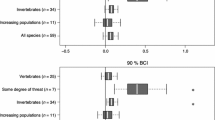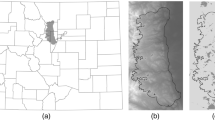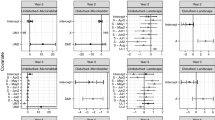Abstract
Markov chains have been frequently used in community ecology to model successional changes, but little attention has been paid to its application in population ecology as a tool to explore the outcomes of species interactions. Markov models can be regarded as “null models” that provide predicted values under a no-change scenario against which the consequences of changes in variables of interest can be assessed. Here we explore Markov chains’ potential to project population trends of competing species and derive sensible management strategies. To do that we use six years of field data on territory occupancy and turn-over of two competing top predators in a Mediterranean landscape: the golden and Bonelli’s eagles. The results suggest that long-term coexistence of both species in the study area is likely, with the main limitation for their coexistence being the difficulties Bonelli’s eagles have in colonising new territories that become available. To avoid future declines in the population of Bonelli’s eagle, it is important to take into account that the positive effects of conservation strategies focused on encouraging colonization (e.g. decreasing disperser mortality) are likely to be larger than those focused on avoiding territory abandonment (e.g. decreasing adult mortality). Markov chains are likely to be useful to evaluate the relative merit of alternative management options in other territorial species when patterns of territory occupancy are the only reliable data available, as often happens with large predators.





Similar content being viewed by others
References
Anderson TW, Goodman LA (1957) Statistical inferences about Markov chains. Ann Math Stat 28:89–110. doi:10.1214/aoms/1177707039
Arroyo B (2004) Águila real, Aquila chrysaetos. In: Madroño A, González C, Atienza JC (eds) Red book of the birds of Spain. Dirección General para la Conservación de la Biodiversidad-SEO/BirdLife, Madrid, pp 151–153
Arroyo B, Ferreiro E, Garza V (1990) El Águila Real (Aquila chrysaetos) en España: Censo, distribución, reproducción y conservación. Instituto Nacional para la Conservación de la Naturaleza (ICONA), Madrid
Barlett MS (1955) An introduction to stochastic processesm, with special reference to methods and applications. Cambridge University Press, Cambridge
BirdLife International (2004) Birds in Europe: population estimates trends and conservation status. BirdLife International, Cambridge
Burnham KP, Anderson DR (1998) Model selection and inference: a practical information—theoretical approach. Springer, New York
Cadahía L, Urios V, Negro JJ (2005) Survival and movements of satellite-tracked Bonelli’s Eagles Hieraaetus fasciatus during their first winter. Ibis 147:415–419. doi:10.1111/j.1474-919x.2005.00405.x
Cadahía L, Negro J, Urios V (2006) Low mitochondrial DNA diversity in the endangered Bonelli’ s Eagle (Hieraaetus fasciatus) from SW Europe (Iberia) and NW Africa. J Ornithol 148:99–104. doi:10.1007/s10336-006-0107-z
Carrete M, Sánchez-Zapata JA, Martinez JE et al (2002a) Predicting the implications of conservation management: a territorial occupancy model of Bonelli’s eagle in Murcia, Spain. Oryx 36:349–356. doi:10.1017/S0030605302000698
Carrete M, Sánchez-Zapata JA, Martinez JE et al (2002b) Factors influencing the decline of a Bonelli’s eagle Hieraaetus fasciatus population in southeastern Spain: demography, habitat or competition? Biodivers Conserv 11:975–985. doi:10.1023/A:1015856924451
Carrete M, Sánchez-Zapata JA, Calvo JF et al (2005) Demography and habitat availability in territorial occupancy of two competing species. Oikos 108:125–136. doi:10.1111/j.0030-1299.2005.12942.x
Carrete M, Sánchez-Zapata JA, Tella JL et al (2006) Components of breeding performance in two competing species: habitat heterogeneity, individual quality and density-dependence. Oikos 112:680–690. doi:10.1111/j.0030-1299.2006.14528.x
Caswell H (2001) Matrix population models: construction, analysis and interpretation, 2nd edn. Sinauer Associates, Inc. Publishers, Sunderland
Caswell H (2007) Sensitivity analysis of transient population dynamics. Ecol Lett 10:1–15. doi:10.1111/j.1461-0248.2006.01001.x
Cheylan G (1981) Sur le rôle déterminant de l’alimentation dans le succès de reproduction de l’Aigle de Bonelli (Hieraaetus fasciatus) en Provence. Rapaces Mediterranees I:95–99
Cramp S, Simmons KEL (1980) The birds of Western Paleartic II: hawks to bustards. Oxford University Press, Oxford
Del Hoyo J, Elliot A, Sargatal J (1994) Handbook of the birds of the world. 2. New world vultures to guineafowl. Lynx Edicions, Barcelona
Del Moral J (2006) El águila perdicera en España. Población en 2005 y método de censo. SEO/BirdLife, Madrid
Ferguson-Lees J, Christie DA (2001) Raptors: birds of prey of the world. A and C Black Pub., Ltd., London
Fernández C, Insausti JA (1990) Golden eagles take up territories abandoned by Bonelli’s eagles in Northern Spain. J Raptor Res 24:124–125
Ferrer M, Hiraldo F (1992) Man-induced sex-biased mortality in the Spanish imperial eagle. Biol Conserv 60(1):57–60. doi:10.1016/0006-3207(92)90799-S
Ferrer M, Penteriani V, Balbontín J et al (2003) The proportion of immature breeders as a reliable early warning signal of population decline: evidence from the Spanish imperial eagle in Doñana. Biol Conserv 114:463–466. doi:10.1016/S0006-3207(03)00085-5
Gibson DJ, Ely JS, Looney PB (1997) A Markovian approach to modelling succession on a coastal barrier island following beach nourishment. J Coast Res 13:831–841
Gil-Sánchez JM, Molino F, Valenzuela G (1994) Parámetros reproductivos y de alimentación del Águila real (Aquila chrysaetos) y del Águila perdicera (Hieraaetus fasciatus) en la provincia de Granada. Aegypius 12:47–51
Gil-Sánchez JM, Moleón M, Otero M et al (2004) A nine-year study of successful breeding in a Bonelli’s eagle population in southeast Spain: a basis for conservation. Biol Conserv 118:685–694. doi:10.1016/j.biocon.2003.10.017
Gotelli NJ (2001) A primer of ecology, Third edn. Sinauer Associates, Inc. Publishers, Sunderland
Gotelli NJ, Graves GR (1996) Null models in ecology. Smithsonian Institution Press, Washington, DC
Gotelli NJ, Ellison AM (2004) A primer of ecological statistics. Sinauer Associates, Inc. Publishers, Sunderland
Hanski I (1983) Coexistence of competitors in patchy environment. Ecology 64:493–500. doi:10.2307/1939969
Hanski I (1999) Metapopulation ecology. Oxford University Press, New York
Hill MF, Witman JD, Caswell H (2002) Spatio-temporal variation in Markov chain models of subtidal community succession. Ecol Lett 5:665–675. doi:10.1046/j.1461-0248.2002.00371.x
Horn HS (1975) Markovian processes of forest succession. In: Cody M, Diamond J (eds) Ecology and Evolution of Communities. Harvard University Press, Cambridge, pp 196–213
Jordano P (1981) Relaciones interespecíficas y coexistencia entre el Águila Real (Aquila chrysaetos) y el Águila Perdicera (Hieraaetus fasciatus) en Sierra Morena central. Ardeola 28:67–88
López-López P, García-Ripollés C, García-López F et al (2004) Distribution pattern among Golden Eagle Aquila chrysaetos and Bonelli’s Eagle Hieraaetus fasciatus in the Castellón province. Ardeola 51:275–283
López-López P, García-Ripollés C, Aguilar JM et al (2006) Modelling breeding habitat preferences of Bonelli’s eagle (Hieraaetus fasciatus) in relation to topography, disturbance, climate and land use at different spatial scales. J Ornithol 147:97–106. doi:10.1007/s10336-005-0019-3
López-López P, García-Ripollés C, Soutullo A et al (2007a) Identifying potentially suitable nesting habitat for golden eagles (Aquila chrysaetos) applied to “important bird areas” design. Anim Conserv 10:208–218. doi:10.1111/j.1469-1795.2006.00089.x
López-López P, García-Ripollés C, Urios V (2007b) Population size, breeding performance and territory quality of Bonelli’s eagle (Hieraaetus fasciatus) in eastern Iberian Peninsula. Bird Study 54:335–342
Moilanen A, Hanski I (1995) Habitat destruction and coexistence of competitors in a spatially realistic metapopulation model. J Anim Ecol 64:141–144. doi:10.2307/5836
Naves J, Wiegand T, Revilla E et al (2003) Endangered species constrained by natural and human factors: The case of brown bears in northern Spain. Conserv Biol 17:1276–1289. doi:10.1046/j.1523-1739.2003.02144.x
Nee S, May RM (1992) Dynamics of metapopulations—habitat destruction and competitive coexistence. J Anim Ecol 61:37–40. doi:10.2307/5506
Newton I (1979) Population ecology of raptors. T & AD Poyser, Berkhamstead
Ontiveros D, Pleguezuelos JM (2000) Influence of prey densities in the distribution and breeding success of Bonelli’s eagle (Hieraaetus fasciatus): management implications. Biol Conserv 93:19–25. doi:10.1016/S0006-3207(99)00117-2
Ontiveros D, Real J, Balbontín J et al (2004) Conservation biology of the Bonelli’s Eagle in Spain: research and management. Ardeola 51:461–470
Ontiveros D, Pleguezuelos JM, Caro J (2005) Prey density, prey detectability and food habits: the case of Bonelli’s eagle and the conservation measures. Biol Conserv 123:19–25. doi:10.1016/j.biocon.2004.10.004
Palomares F, Ferreras P, Fedriani JM et al (1996) Spatial relationships between Iberian lynx and other carnivores in an area of south-western Spain. J Appl Ecol 33:5–13. doi:10.2307/2405010
Parellada X, Borau JA, Beneyeto A (1996) El águila perdicera (Hieraaetus fasciatus) en Catalunya (NE de España): estatus y plan de conservación. In: Muntaner J, Mayol J (eds) Biología y Conservación de las Rapaces Mediterráneas. Monografía no. 4. SEO/Birdlife, Madrid, pp 231–237
Pedrini P, Sergio F (2002) Regional conservation priorities for a large predator: golden eagles (Aquila chrysaetos) in the Alpine range. Biol Conserv 103:163–172. doi:10.1016/S0006-3207(01)00116-1
Pounds JA, Bustamante MR, Coloma LA et al (2006) Widespread amphibian extinctions from epidemic disease driven by global warming. Nature 439:161–167. doi:10.1038/nature04246
Real J (2004) Águila-azor perdicera, Hieraaetus fasciatus. In: Madroño A, González C, Atienza JC (eds) Red book of the birds of Spain. Dirección General para la Biodiversidad-SEO/Birdlife, Madrid, pp 154–157
Real J, Mañosa S (1997) Demography and conservation of western European Bonelli’s eagle Hieraaetus fasciatus populations. Biol Conserv 79:59–66. doi:10.1016/S0006-3207(96)00100-0
Schwartz MK, Mills LS, McKelvey KS et al (2002) DNA reveals high dispersal synchronizing the population dynamics of Canada lynx. Nature 415:520–522. doi:10.1038/415520a
Sergio F, Marchesi L, Pedrini P (2003) Spatial refugia and the coexistence of a diurnal raptor with its intraguild owl predator. J Anim Ecol 72:232–245. doi:10.1046/j.1365-2656.2003.00693.x
Soutullo A, López-López P, Urios V (2008) Incorporating spatial structure and stochasticity in endangered Bonelli’s eagle’s population models: Implications for conservation and management. Biol Conserv 141:1013–1020. doi:10.1016/j.biocon.2008.01.011
Steenhof K, Kochert MN (1982) An evaluation of methods used to estimate raptor nesting success. J Wildl Manage 46:885–893. doi:10.2307/3808221
Steenhof K, Kochert MN, McDonald TL (1997) Interactive effects of prey and weather on golden eagle reproduction. J Anim Ecol 66:350–362. doi:10.2307/5981
Tilman D (1994) Competition and biodiversity in spatially structured habitats. Ecology 75:2–16. doi:10.2307/1939377
Usher MB (1979) Markovian approaches to ecological succession. J Anim Ecol 48:413–426. doi:10.2307/4170
Whitfield DP, Fielding AH, McLeod DRA et al (2004) Modelling the effects of persecution on the population dynamics of golden eagles in Scotland. Biol Conserv 119:319–333. doi:10.1016/j.biocon.2003.11.015
Wootton JT (2001) Prediction in complex communities: analysis of empirically derived Markov models. Ecology 82:580–598
Acknowledgments
Thanks are due to F. García-López and J. M. Aguilar for helping in the field work. The Conselleria de Territori i Habitatge of the Generalitat Valenciana provided financial support to complete the monitoring of the 2005 breeding season (Project N/REF. 28/BD/05). We would like to thank especially J. Jiménez and P. Mateache for their support and personal communications. P. Whitfield, M. Carrete and two anonymous referees made interesting comments on early drafts of the manuscript. The paper complies with the current laws of Spain. P. López-López is supported by a FPU grant of the Spanish Ministerio de Educación y Ciencia (reference AP2005-0874). This paper is a part of P. López-López Ph.D. thesis.
Author information
Authors and Affiliations
Corresponding author
Rights and permissions
About this article
Cite this article
López-López, P., Soutullo, A., García-Ripollés, C. et al. Markov models of territory occupancy: implications for the management and conservation of competing species. Biodivers Conserv 18, 1389–1402 (2009). https://doi.org/10.1007/s10531-008-9469-2
Received:
Accepted:
Published:
Issue Date:
DOI: https://doi.org/10.1007/s10531-008-9469-2




